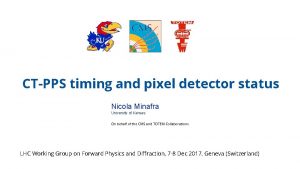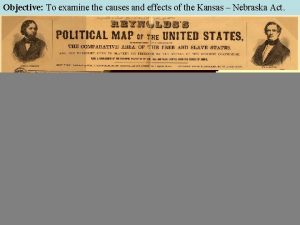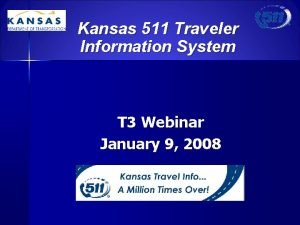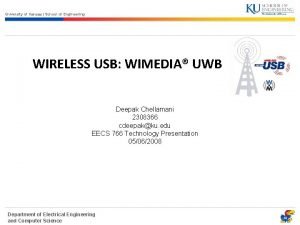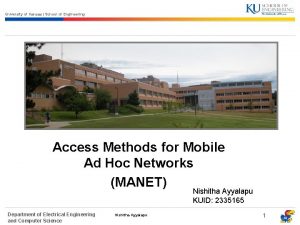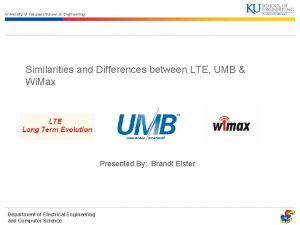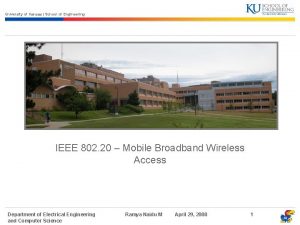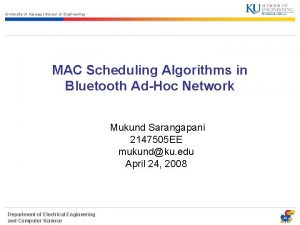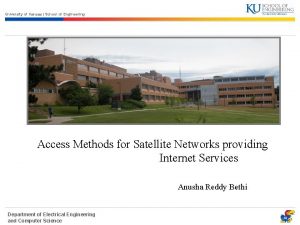University of Kansas School of Engineering EECS 766








































- Slides: 40

University of Kansas | School of Engineering EECS 766 : Resource Sharing for Broadband Access Networks GPON Evolution towards WDM PON Ashwini Shikaripur Nadig KU ID : 2332269 April 29 th, 2008 Department of Electrical Engineering and Computer Science

University of Kansas | School of Engineering Abstract In the last few years, access networks based on Fiber-to-the-Home(FTTH) has been proven to be the most promising fixed internet access service. Gigabit- capable PON systems such as GE-PON (IEEE standard 802. 3 ah) and GPON (ITU-T Recommendation G. 984 series) are now being deployed to support broadband optical access services. The key driver for GPON is the expected consumer bandwidth demand for IP-based standard definition TV (SDTV) and particularly HDTV services. We discuss the basic architecture of GPON, media access control and the basic frame formats. The next part of this presentation, deals with the evolution towards another flavor of PON; PONs with Wavelength Division Multiplexing. The basic concepts and architecture of WDM PON Networks, and why these networks can be considered as possible next generation PONs are discussed. Department of Electrical Engineering and Computer Science

University of Kansas | School of Engineering OUTLINE § § § § Introduction GPON System Architecture GPON Encapsulation Method (GEM) Protocol Stack for the GTC system GPON Media Access Control Traffic flow and Qo. S Dynamic Bandwidth Assignment (DBA) GTC TC Frame Formats Evolution towards WDM PON Motivation for WDM PON Architectures Advantages of WDM PON Challenges of WDM PON Conclusions References Department of Electrical Engineering and Computer Science

University of Kansas | School of Engineering Introduction § The progress in the technology, the need for larger bandwidths and the unquestionable complexity of ATM forced the FSAN (Full Service Access Network) group to revise their approach. . § In 2001, they initiated the development of the standard GPON (Gigabit-capable PON, Rec. G. 984, ITU-T, 2003) for full service support including voice, Ethernet, ATM, leased lines, wireless extension etc. § In the outcome GPON was released and adopted by ITU in 2003. § The GPON’s functionality is heavily based on its predecessor (BPON), although it is no longer reliant on ATM as its underlying protocol. § A much simpler Generic Framing Procedure (GFP) is used to provide support for both voice and data oriented services. § A big advantage of GPON over other schemes is that interfaces to all the main services are provided and in GFP enabled networks, packets belonging to different protocols can be transmitted in their native formats. § Security is a key issue. A sophisticated mechanism based on Advanced Encryption Standard and a complex exchange of unique keys is built into the GPON architecture. Department of Electrical Engineering and Computer Science 1

University of Kansas | School of Engineering GPON System Architecture Fig 1. GPON (Gigabit-capable PON) –Architecture From : Henrique J. A. da Silva “Optical Access Networks” http: //www. co. it. pt/seminarios/webcasting/itcbr_09_03_05. pdf, [11] Department of Electrical Engineering and Computer Science 2

University of Kansas | School of Engineering General Characteristics Bit rate : Downstream – 1244. 16 Mbps/2488. 32 Mbps Upstream – 155. 52 Mbps/622. 08 Mbps/1244. 16 Mbps/2488. 32 Mbps Wavelengths : Downstream – 1260 to 1360 nm Upstream – 1480 to 1500 nm Logical reach : Logical reach is the maximum distance between ONU/ONT and OLT except for the limitation of the physical layer. In GPON the maximum logical reach is defined as 60 km Physical reach : Physical reach is the maximum physical distance between the ONU/ONT and OLT. In GPON two options are defined for the physical reach : 10 km and 20 km. It is assumed that 10 km is the maximum distance over which FP-LD can be used in the ONU for high bit rates such as 1. 25 Gbps or above Differential fibre distance : Maximum differential fibre distance is 20 km Maximum mean signal transfer delay : Maximum of 1. 5 ms is tolerated Split ratio : Upto 1: 64 are realistic. Anticipating 1: 128 in future Traffic type : Digital only Department of Electrical Engineering and Computer Science 3

University of Kansas | School of Engineering GPON System Configuration Fig 2. G-PON system configuration From : ITU-T G. 984. 3 -Gigabit-capable Passive Optical Networks (G-PON): Transmission convergence layer specification - http: //www. itu. int/rec/T-REC-G. 984. 3 -200402 -S/en, [5] Department of Electrical Engineering and Computer Science 4

University of Kansas | School of Engineering GPON Functional Blocks OLT ( Optical Line Termination) The OLT consists of three major parts: 1. Service port interface function 2. Cross-connect function 3. Optical Distribution Network interface PON core shell : 1. ODN Interface function 2. PON TC function includes framing, media access control, OAM, DBA, ONU management and mode selection. Cross-connect shell : Communication path between PON core shell and Service shell Fig 3. OLT functional block diagram From : ITU-T G. 984. 3 -Gigabit-capable Passive Optical Networks (G-PON): Transmission convergence layer specification - http: //www. itu. int/rec/T-REC-G. 984. 3 -200402 -S/en, [5] Department of Electrical Engineering and Computer Science Service shell : Translation between service interfaces and TC frame interface of the PON section. 5

University of Kansas | School of Engineering GPON Functional Blocks ONU (Optical Network Unit) § Similar to OLT. § Since ONU operates with only a single PON interface, the cross connect shell can be omitted. § MUX and DMUX handle traffic. Fig 4. ONU functional block diagram From : ITU-T G. 984. 3 -Gigabit-capable Passive Optical Networks (G-PON): Transmission convergence layer specification - http: //www. itu. int/rec/T-REC-G. 984. 3 -200402 -S/en, [5] ODN (Optical Distribution Network) Connects between an OLT and one or more ONUs using passive optical device. Department of Electrical Engineering and Computer Science 6

University of Kansas | School of Engineering GPON Encapsulation Method (GEM) § Two modes of operation : ATM, GEM Fig 7. Embedded GEM From : ITU-T G. 984. 3 -Gigabit-capable Passive Optical Networks (G-PON): Transmission convergence layer specification - http: //www. itu. int/rec/T-REC-G. 984. 3 -200402 -S/en, [5] § Embedded into the PON section. § Independent of the type of SNI and UNI. § The GEM flow consists of long 125 -us GPON frames, whose length may or may not match that of the client user. § If user packet is shorter, then encapsulation is required. § If user packets are longer, then fragmentation is done. Department of Electrical Engineering and Computer Science 12

University of Kansas | School of Engineering Protocol Stack for the GTC system GTC (GPON Transmission Convergence) layer between physical media and GPON clients. The GTC layer is composed of two sub layers: 1. GTC Framing sub-layer 2. TC adaptation sub-layer Fig 5. Protocol stack for the GTC system Two views : § C/M plane – manages user traffic flows, security and other features § U plane – carries user traffic From : ITU-T G. 984. 3 -Gigabit-capable Passive Optical Networks (G-PON): Transmission convergence layer specification - http: //www. itu. int/rec/T-REC-G. 984. 3 -200402 -S/en, [5] Department of Electrical Engineering and Computer Science 7

University of Kansas | School of Engineering Functions of GTC layer The main function of the GPON Transmission Convergence (GTC) layer is to provide transport multiplexing between the OLT and ONUs. Other functions include : § Adaptation of client layer signal protocols § Physical layer OAM (PLOAM) functions § Interface for dynamic bandwidth allocation (DBA) § ONU ranging and registration § Forward error correction (optional) § Downstream data encryption (optional) § Communication channel for the OMCI Department of Electrical Engineering and Computer Science 8

University of Kansas | School of Engineering C/M Planes Control and Management planes Consists of three parts : Embedded OAM ( Operation, Administration and Maintenance) : § Low latency path for time urgent control information § Granting § Key switching for security § DBA related functionalities PLOAM (Physical Layer OAM) : It provides PON management functionalities : § Ranging § Activation of ONU § Establishment of OMCC (ONU Management and Control Channel) § Alarm transfer OMCI (ONU Management and Control Interface) : § Manage the service defining layers that lay above the GTC. § The GTC must provide a transport interface for the traffic in ATM or GEM Department of Electrical Engineering and Computer Science 9

University of Kansas | School of Engineering U plane § Traffic flows are identified by their traffic type (ATM or GEM). § The traffic type is implicitly indicated by which downstream partition or upstream allocation ID carries the data. § The 12 bit Port ID is used to identify flows in the case GEM traffic. § The VPI is used to identify flows in the case of ATM traffic. GEM : Downstream § GEM frames are carried in the GEM partition. § The ONU framing sub-layer extracts the cells. § GEM TC Adapter filters the frames. Upstream § The GEM traffic is carried over one or more T-CONTs. § The OLT receives the transmission associated with the T-CONT identified by Alloc-ID. Fig 6. Protocol stack for U-Plane and identification by partition § Frames are forwarded to the GEM TC adapter, and then and Port-ID or VPI From : ITU-T G. 984. 3 -Gigabit-capable Passive Optical Networks (G-PON): Transmission the GEM client. convergence layer specification - http: //www. itu. int/rec/T-REC-G. 984. 3 -200402 -S/en, [5] ATM : (similar to GEM) Department of Electrical Engineering and Computer Science 10

University of Kansas | School of Engineering Functions of sub-layers in GTC framing sub-layer has the following functionalities : Multiplexing and demultiplexing : § PLOAM, ATM and GEM portions are multiplexed into a downstream TC frame according to boundary information indicated in frame header. § Each portion is abstracted from an upstream according to header indicator. Header creation and decode : § TC frame header is created and is formatted in a downstream frame. § Header in upstream frame is decoded. § Moreover, Embedded OAM is performed. Internal routing function based on Alloc-ID : § Routing based on Alloc-ID is performed for data from/to ATM and GEM TC Adapters. GTC adaptation sub-layer, and the adapters provide the ATM/GEM interfaces for upper layer entities § ATM TC adapter § GEM TC adapter § OMCI adapter Department of Electrical Engineering and Computer Science 11

University of Kansas | School of Engineering T-CONT (Transmission Containers) GTC functions are realized through transmission containers or T-CONTs. § T-CONTs are used for the management of upstream bandwidth allocation. § T-CONTs carry ATM VPCs/VCCs and/or GEM Port and report their buffer status to their associated OLTs. § T-CONTs dynamically receive grants, identified by Alloc-ID, from the OLT. § A single T-CONT can carry ATM or GEM traffic with various service classes. § A T-CONT can accommodate one or more physical queues and aggregates them into a single logical buffer. § A DBA-T-CONT status report summarizes the status of the logical buffer of that T-CONT. § Information traversing a T-CONT is unchanged except where degradation occurs in the transfer process. § A data grant is associated with one and only one T-CONTs physically occur in the ONU hardware and software. GPON is not backward compatible with BPONs. Most GPONs implement GEM based T-CONTs. Department of Electrical Engineering and Computer Science 13

University of Kansas | School of Engineering GPON Media Access Control § GTC provides media access control for upstream traffic. § The PCBd (Physical Control Block downstream) contains media access control information in the upstream (US) bandwidth (BW) map. § OLT sends pointers in the PCBd, and these pointers indicate the time at which each ONU may begin and end its upstream transmission. Fig 8. GTC TC media access control concept (one T-CONT per ONU case) From : ITU-T G. 984. 3 -Gigabit-capable Passive Optical Networks (G-PON): Transmission convergence layer specification - http: //www. itu. int/rec/T-REC-G. 984. 3 -200402 -S/en, [5] Department of Electrical Engineering and Computer Science 14

University of Kansas | School of Engineering Traffic flow and Qo. S § In general, the GTC system considers the traffic management of T-CONTs, and each T-CONT is identified by an Alloc-ID. § The OLT monitors traffic loading on each T-CONT, and makes adjustments to the bandwidth allocations to appropriately distribute the PON resources. § Resources are allocated statically or dynamically. § Qo. S is guaranteed by DBA functionalities, IP Diff. Serv Code Points (DSCPs), IEEE 802. 1 p. § The GPON Encapsulation Method (GEM), with identification of ports, makes it possible to separate up to eight different types of traffic at the entrance and exit of the network. Thus, traffic can be queued according to service. § The key aspect of GPON’s low-latency capability is that all upstream TDMA bursts from all ONUs can occur within an 8 -k. Hz frame (125 μsec). § Each downstream frame includes an efficient bandwidth allocation map that is broadcast to all ONUs and can support a fine granularity of bandwidth allocation. § This out-of-band mechanism enables the GPON DBA to support very small grant cycles without compromising bandwidth utilization. § GPON Encapsulation Method (GEM) allows very efficient packaging of user traffic, with frame segmentation to allow for higher Quality of Service (Qo. S) for delay-sensitive traffic such as voice and video communications. Department of Electrical Engineering and Computer Science 15

University of Kansas | School of Engineering Traffic flow and Qo. S There are three ways that ONUs may communicate the status of pending traffic to the OLT : § Status indication bits in PLOu. Status indication gives OLT a quick and simple way of knowing the type of upstream traffic waiting, without much details. § Piggyback DBA report in the DBRu. This allows ONUs to continuously update the traffic of a specific T-CONT. The DBA report contains the number of ATM cells or GEM blocks waiting in the upstream buffer. § DBA upstream payload. An ONU can send a dedicated whole report of traffic status on any or all its T-CONT in the upstream payload. Department of Electrical Engineering and Computer Science 16

University of Kansas | School of Engineering Dynamic Bandwidth Assignment (DBA) DBA functionalities : § Detection of congestion status by OLT and/or ONU. § Report of congestion status to OLT. § Update of assigned bandwidth by OLT according to provisioned parameters. § Issues of grants by OLT according to updated bandwidths and T-CONT types. § Management issues for DBA operations; All of the DBA parameters should be provisioned or negotiated by GPON OMCI. § In GPON DBA five T-CONT types (T-CONT types 1, 2, 3, 4 and 5) are specified. Department of Electrical Engineering and Computer Science 17

University of Kansas | School of Engineering Dynamic Bandwidth Assignment (DBA) In DBA operations, there are two modes SR (Status Reporting)-DBA and NSR (Non Status Reporting)DBA in every T-CONT § SR (Status Reporting)-DBA provides bandwidth assignment according to report from ONU. § NSR (Non Status Reporting)-DBA invokes bandwidth assignment which does not need report from ONU. However, it provides dynamic assignment by using traffic monitoring by OLT itself. Department of Electrical Engineering and Computer Science 18

University of Kansas | School of Engineering SR (Status Reporting)-DBA When a T-CONT sends upstream data from ONU to OLT, the number of cells or blocks in the TCONT buffer is set in the DBA field of DBRu (Dynamic Bandwidth Report upstream). Fig 9. Summary of SR-DBA operation From : ITU-T G. 984. 3 -Gigabit-capable Passive Optical Networks (G-PON): Transmission convergence layer specification - http: //www. itu. int/rec/T-REC-G. 984. 3 -200402 -S/en, [5] Department of Electrical Engineering and Computer Science 19

University of Kansas | School of Engineering GTC TC frame formats (Downstream) Fig 10. GTC TC downstream frame Fig 11. GTC TC Physical Control Block downstream (PCBd) From : ITU-T G. 984. 3 -Gigabit-capable Passive Optical Networks (G-PON): Transmission convergence layer specification - http: //www. itu. int/rec/T-REC-G. 984. 3 -200402 -S/en, [5] Department of Electrical Engineering and Computer Science 20

University of Kansas | School of Engineering GTC TC frame formats (Upstream) Fig 12. GTC upstream frame From : ITU-T G. 984. 3 -Gigabit-capable Passive Optical Networks (G-PON): Transmission convergence layer specification - http: //www. itu. int/rec/T-REC-G. 984. 3 -200402 -S/en, [5] The upstream frame consists of multiple transmission bursts from one or more ONUs. Each ONU can transmit one or more of the PON overheads : § Physical Layer Overhead (PLOu) § Physical Layer Operations, Administration and Management upstream (PLOAMu) § Power Leveling Sequence upstream (PLSu) § Dynamic Bandwidth Report upstream (DBRu) Department of Electrical Engineering and Computer Science 21

University of Kansas | School of Engineering GTC TC frame formats (Upstream) Fig 13. GTC upstream overheads detail From : ITU-T G. 984. 3 -Gigabit-capable Passive Optical Networks (G-PON): Transmission convergence layer specification - http: //www. itu. int/rec/T-REC-G. 984. 3 -200402 -S/en, [5] Every time an ONU takes over the PON medium from another ONU, it must send a new copy of the PLOu data includes the physical layer overhead and three fields of data. § Preamble and delimiter § BIP (Bit Interleaved Parity) § ONU-ID § Ind – real time ONU status report to OLT PLOAMu PLSu is used for power control measurements by the ONU. DBRu (Dynamic Bandwidth Report upstream) § DBA field – contains the traffic status of the T-CONT in question § CRC Payload : § ATM cell § GEM header and frame fragment § DBA report and CRC Department of Electrical Engineering and Computer Science 22

University of Kansas | School of Engineering Evolution towards WDM PON Department of Electrical Engineering and Computer Science 23

University of Kansas | School of Engineering Electronic Bottleneck § Theoretically fiber has extremely high bandwidth (about 25 THz) in the 1. 55 low attenuation band, and this is 1000 times the total bandwidth of radio on this planet earth. § Speeds (data rates) of only a few gigabits per second are achieved - rate is limited by electronic speed. § Hence it is extremely difficult to exploit all of the huge bandwidth of a single fiber using a single high -capacity wavelength channel due to opto-electronic bandwidth mismatch or “electronic bottleneck”. § This problem can be reduced by Wavelength Division Multiplexing. Department of Electrical Engineering and Computer Science 24

University of Kansas | School of Engineering Motivation for WDM PONs § Most agree that TDMA PONs cannot cope with the requirements of future network evolution with respect to aggregated bandwidth and the allowable power budget. § The power budget limits both the PON splitting ratio and the reach/distance between OLT and ONU. § The use of passive 1: N power splitters leads to severe losses (for example, a 1: 32 splitter imposes an insertion/splitting loss > 17 d. B) and limits the attainable link lengths. § The recent breakthroughs (Tb/s) are the result of two major developments : Ø Wavelength Division Multiplexing (WDM), which is a method of sending many light beams of different wavelengths simultaneously down the core of an optical fiber. Ø Erbium-Doped Fiber Amplifier (EDFA), which amplifies signals at many different wavelengths simultaneously, regardless of their modulation scheme or speed. Department of Electrical Engineering and Computer Science 25

University of Kansas | School of Engineering WDM PON Architectures Many proposals have been made in recent years. All of these proposals assume Dense WDM PONs or Ultra Dense WDM PONs. Dominant criteria for commercial success : § Cost § Performance (i. e. , bandwidth per user) § Splitting ratio § Maximum reach Basic WDM Architectures : § Broadcast-and-select architecture § AWG based (arrayed waveguide grating) wavelength-routing PON § Wavelength routing with spectrum slicing based on LED-based colorless ONUs All of these make use of Multi Frequency Laser (MFL). Department of Electrical Engineering and Computer Science 26

University of Kansas | School of Engineering WDM PON Architectures Broadcast-and-select Fig 14 : broadcast-and-select WDM-PON with splitter/combiner in passive mode From : Klaus Grobe and Jörg-Peter Elbers, ADVA AG Optical Networking, “PON in Adolescence : From TDMA to WDM-PON” http: //ieeexplore. ieee. org/iel 5/35/4427218/04427227. pdf? tp=&arnumber=4427227&isnumber=4427218 , [7] § Broadcasts all wavelengths in the downstream (DS) through a passive 1: N splitter. § ONU selects its wavelength using a filter. § Uses another individual wavelength for the upstream. Disadvantages : § Loss incurred due to passive splitter/combiner. § Broadcast security issues. § Identical ONUs can’t be used unless both the receiver filters and transmitters are tunable. Department of Electrical Engineering and Computer Science 27

University of Kansas | School of Engineering WDM PON Architectures AWG based wavelength-routing PON Fig 15 : AWG based wavelength routing PON From : Klaus Grobe and Jörg-Peter Elbers, ADVA AG Optical Networking, “PON in Adolescence : From TDMA to WDM-PON” http: //ieeexplore. ieee. org/iel 5/35/4427218/04427227. pdf? tp=&arnumber=4427227&isnumber=4427218 , [7] Passive splitter replaced by AWG (arrayed waveguide grating) wavelength router. Advantages : § Low insertion loss ( AWG have typical insertion loss of 5 d. B). § Simple ONUs (wavelength selective individual receivers are not necessary). Tunable transmit wavelengths are still necessary. Department of Electrical Engineering and Computer Science 28

University of Kansas | School of Engineering WDM PON Architectures § With a normal WDM multiplexer, an “out of range” wavelength at the input port is blocked from reaching the output port. § A variant of the wavelength routed PON uses cascaded AWG filters. - improved scalability. Makes use of Periodic Routing Behavior of AWG filters. § § In an AWG, the Free Spectral Range (FSR) is the frequency difference between two wavelengths that can both be routed to the same output port. § The AWG device is designed so that its wavelength demultiplexing property repeats over periods of FSRs. § The resulting routing capability is also referred to as Dynamic Wavelength Assignment (DWA). Department of Electrical Engineering and Computer Science 29

University of Kansas | School of Engineering WDM PON Architectures Wavelength routing with spectrum slicing based on LED based colorless ONUs Fig 16 : wavelength routing with spectrum slicing based on LED based colorless ONUs From : Klaus Grobe and Jörg-Peter Elbers, ADVA AG Optical Networking, “PON in Adolescence : From TDMA to WDM-PON” http: //ieeexplore. ieee. org/iel 5/35/4427218/04427227. pdf? tp=&arnumber=4427227&isnumber=4427218 , [7] § Single (shared) wavelength for the upstream (US) -> identical ONUs. § Referred to as composite PON (CPON). § Need for US TDMA techniques. § In the OLT, circulators can be used instead of band splitters (BS) to enable SFW (Single Fiber Working). § Ultra-broadband sources (e. g. , LEDs) can be used in the ONUs § In AWG router US signals are spectrally sliced. - identical ONUs. Disadvantages : § Spectrum slicing leads to poor power budget. § US bandwidth is limited and multiple-access (burst mode) techniques are required. Department of Electrical Engineering and Computer Science 30

University of Kansas | School of Engineering Advantages of WDM PON § The optical distribution plant is still passive and therefore has the same low-maintenance and high reliability properties of PS-PON § Each user receives its own wavelength. Therefore WDM-PON offers excellent privacy § P 2 P connections between OLT and ONUs are realized in wavelength domain. - There is no P 2 MP media access control required. - This greatly simplifies the MAC layer. - There will not be distance limitation imposed by ranging and DBA protocols § Easy pay-as-you-grow upgrade. - In a PS-PON, if the OLT speed is increased, all ONUs need to be upgraded at the same time. - Such a problem does not exist with WDM-PONs. - Each wavelength in a WDM-PON can run at a different speed as well as with a different protocol. - Individual user pays for his or her own upgrade Department of Electrical Engineering and Computer Science 31

University of Kansas | School of Engineering Challenges of WDM PON § High costs of WDM components. § Temperature control. - WDM components’ wavelengths tend to drift with environmental temperatures. - Temperature control consumes power and requires active electronic parts in the optical distribution network. § Colorless ONU operation. - Each ONU needs a different wavelength for upstream connection. Presents a rather serious operational and economic issue. - Wavelength specific ONU introduces significant challenges in managing production lines, inventory stocks, sparing and maintenance. Department of Electrical Engineering and Computer Science 32

University of Kansas | School of Engineering Conclusions ITU-T has completed the standardization of the PON for downstream 2. 5 Gbps and upstream 1. 25 Gbps. Although 1 Gbps PON system may seem sufficient for accommodating FTTH services, much faster PON systems may be required in regions where there are many business users who need large-capacity leased lines. GPON has been implemented in the U. S. and Europe. In view of this trend, the WDM-PON system that multiplexes high speed services by means of WDM and 10 Gbps PON systems have been intensively studied. WDM PONs, possibly complemented by TDMA and TDM techniques, are the next step in the evolution of PONs. Using optical amplification, they offer higher per-ONU bandwidths, splitting ratios, and maximum reach as compared, to EPON and GPON. Looking at the future of optical access systems, it is estimated that 30 million subscribers will be using FTTH services in 2010. Department of Electrical Engineering and Computer Science 33

University of Kansas | School of Engineering References 1. 2. 3. 4. Cedric Lam, “Passive Optical Networks, Principles and Practice”, Elsevier 2007 C. Siva Ram Murthy and Mohan Guruswamy, “WDM Optical Networks”, Prentice Hall 2002 Paul E. Green Jr. , “FTTH To The Home, The New Empowerment”, John Wiley and Sons 2006 ITU-T G. 984. 1 -Gigabit-capable Passive Optical Networks : General Characteristics http: //www. itu. int/search/pages/ituwebsearch/basic. asp. Query. Submit=true&Page=1&Query. Text=GPON+gen eral+characteristics 5. ITU-T G. 984. 3 -Gigabit-capable Passive Optical Networks (G-PON): Transmission convergence layer specification http: //www. itu. int/rec/T-REC-G. 984. 3 -200402 -S/en 6. Dawid Nowak and John Murphy, "FTTH: The Overview of Existing Technologies" http: //csiweb. ucd. ie/Staff/jmurphy/publications/921. pdf 7. Klaus Grobe and Jörg-Peter Elbers, ADVA AG Optical Networking, “PON in Adolescence : From TDMA to WDM-PON”, Communications Magazine, IEEE, Publication Date: January 2008, Volume: 46, Issue : 1 On page(s): 26 -34 http: //ieeexplore. ieee. org/iel 5/35/4427218/04427227. pdf? tp=&arnumber=4427227&isnumber=4427218 8. Germán Santos-Boada, and Jordi Domingo-Pascual, “Quality of Service in Multioperator GPON Access Networks with Triple-Play Services http: //www. waset. org/ijaset/v 3 -1 -8. pdf 9. Kiyoshi Shimokasa*, Hiroshi Ichibangase** and Kuniaki Motoshima**, “Prospects for Optical Access Network” http: //global. mitsubishielectric. com/pdf/advance/vol 114/114_TR 2. pdf 10. Abrams, M. Maislos, A. Passave Inc. , Santa Clara, CA, USA, “Insights on delivering an IP triple play over GE-PON and GPON”, Publication Date: 5 -10 March 2006, On page(s): 8 pp. http: //ieeexplore. ieee. org/xpls/abs_all. jsp? arnumber=1636653 Department of Electrical Engineering and Computer Science 34

University of Kansas | School of Engineering References 11. Henrique J. A. da Silva “Optical Access Networks” http: //www. co. it. pt/seminarios/webcasting/itcbr_09_03_05. pdf Department of Electrical Engineering and Computer Science 35

University of Kansas | School of Engineering Multiplexing Architectures ATM base and GEM base Fig 17 : Multiplexing architectures in ATM and GEM From : ITU-T G. 984. 3 -Gigabit-capable Passive Optical Networks (G-PON): Transmission convergence layer specification - http: //www. itu. int/rec/T-REC-G. 984. 3 -200402 -S/en, [5] Department of Electrical Engineering and Computer Science 36

University of Kansas | School of Engineering GTC TC Frame formats (Downstream) Fig 18 : GEM header and frame structure From : ITU-T G. 984. 3 -Gigabit-capable Passive Optical Networks (G-PON): Transmission convergence layer specification - http: //www. itu. int/rec/T-REC-G. 984. 3 -200402 -S/en, [5] Department of Electrical Engineering and Computer Science 37
 Chapter 766 schools
Chapter 766 schools Kansas kansas state fight
Kansas kansas state fight Chapter 766
Chapter 766 7.145-2.766
7.145-2.766 Ku writing center
Ku writing center Strategic instruction model examples
Strategic instruction model examples K state counseling
K state counseling K state computer science
K state computer science University of kansas
University of kansas Ku premed
Ku premed University of kansas premed
University of kansas premed Aalto university school of engineering
Aalto university school of engineering University of belgrade school of electrical engineering
University of belgrade school of electrical engineering Case western reserve university case school of engineering
Case western reserve university case school of engineering Oussep osaka
Oussep osaka Binghamton university watson school of engineering
Binghamton university watson school of engineering Kansas city hilton collapse
Kansas city hilton collapse Kansas city hotel collapse
Kansas city hotel collapse State motto of kansas
State motto of kansas Nurse practice act kansas
Nurse practice act kansas Kansas-nebraska act effects
Kansas-nebraska act effects 1600 kansas ave
1600 kansas ave Kansas assessment examiner's manual
Kansas assessment examiner's manual Kansas income tax rates
Kansas income tax rates Common core reading
Common core reading Facts about bleeding kansas
Facts about bleeding kansas Kansashealthquest com
Kansashealthquest com Agricultural accounting and finance kansas
Agricultural accounting and finance kansas Michael merriman kansas city
Michael merriman kansas city Chapter 21: a dividing nation answer key
Chapter 21: a dividing nation answer key 4 types of fog aviation
4 types of fog aviation Is kansas flatter than a pancake
Is kansas flatter than a pancake 1920s stock market simulation
1920s stock market simulation Kansas work ready certificate
Kansas work ready certificate State library of kansas databases
State library of kansas databases Miracles inc wichita ks
Miracles inc wichita ks Math standards kansas
Math standards kansas Pasture rent per acre kansas
Pasture rent per acre kansas Communications strategy in kansas city
Communications strategy in kansas city Kansas board of cosmetology
Kansas board of cosmetology Kansas511
Kansas511








